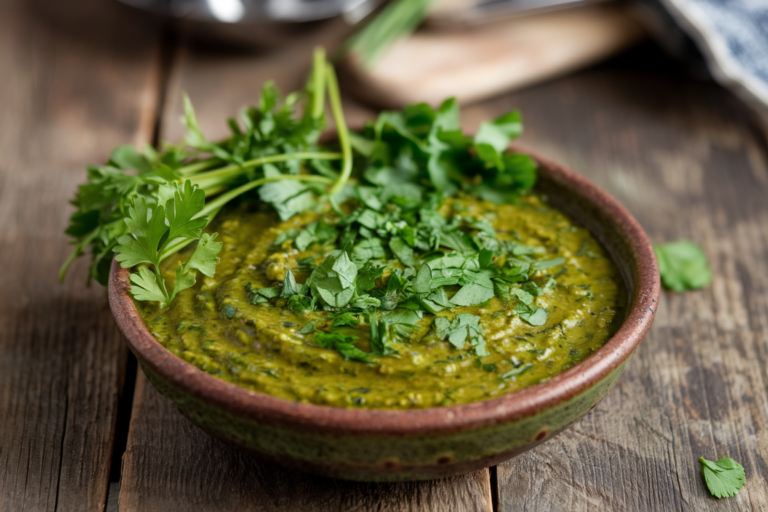Introduction to Chimichurri and Its Versatile Ingredients
Chimichurri is a bright and tangy sauce from Argentina and Uruguay that has become loved around the world. It’s usually made with fresh herbs, olive oil, and vinegar, and is famous for making grilled meats, roasted chicken, and fish taste even better. But can you use stems in chimichurri? This question not only shakes up traditional cooking but also leads to more sustainable and tasty ways to cook. By adding herb stems, you can cut down on waste and boost the flavor of your sauce without losing its unique taste. For more tasty recipes, visit Erin Recipes.
Part 1: Understanding Chimichurri and Its Key Components
1. Introduction to Chimichurri
Chimichurri isn’t just a sauce; it’s a key part of South American cooking. It started in the Argentine pampas, where it was used with the region’s famous barbecue, known as asado. The traditional chimichurri recipe mixes parsley, oregano, garlic, olive oil, and vinegar to create a sauce that is both fresh and tangy. Its versatility makes it a popular choice for marinades, dressings, and dips, adding flavor to everything from meats to vegetables.
2. The Role of Herb Stems in Chimichurri
Herbs are the heart of chimichurri, providing the fresh and vibrant flavors that define the sauce. The most common herbs used are parsley, cilantro, and oregano.
- Parsley offers a clean, earthy taste that forms the base of the sauce.
- Cilantro adds a slightly citrusy and peppery flavor, giving the chimichurri a unique twist.
- Oregano contributes a robust and slightly bitter note that balances the freshness of the parsley and cilantro.
These herbs are typically used in their leafy forms, but the question arises: can you use stems in chimichurri? Including stems can enhance the sauce’s texture and nutrient profile, but it requires careful preparation to maintain the desired consistency.
For more insights on herb usage in cooking, explore our guide on artisan lettuce salads.
3. Can You Use Stems in Chimichurri?
Can you use stems in chimichurri? Absolutely! While traditional recipes focus on the leaves, incorporating stems can offer several benefits:
- Flavor: Herb stems contain concentrated flavors, which can deepen the overall taste of the chimichurri.
- Texture: Finely chopped stems can add a subtle crunch and complexity without overpowering the sauce.
- Nutrients: Stems are rich in vitamins and minerals, enhancing the nutritional value of your chimichurri.
However, it’s essential to prepare the stems properly. Remove any tough or woody parts, and chop them finely to ensure they blend seamlessly with the other ingredients. Culinary traditions vary, but many chefs and home cooks alike have embraced the use of stems to minimize waste and maximize flavor.
For expert tips on utilizing every part of your ingredients, check out our article on how to caramelize brulee.
4. Benefits of Using Herb Stems in Chimichurri
Incorporating stems into your chimichurri offers numerous advantages:
- Economic Benefits: Using stems reduces food waste, allowing you to make the most of your fresh herbs without needing to discard parts.
- Environmental Impact: Sustainable cooking practices, such as utilizing herb stems, contribute to a more eco-friendly kitchen by minimizing waste.
- Flavor Enhancement: Stems can intensify the sauce’s flavor, adding depth and complexity that might be missing when using only leaves.
By adopting this practice, you not only enhance the taste of your chimichurri but also contribute to a more sustainable culinary approach. This aligns with broader trends in the kitchen that emphasize zero waste and resourcefulness.
5. How to Prepare Stems for Chimichurri
Proper preparation of herb stems is crucial to ensure they enhance rather than detract from your chimichurri. Here are some steps to follow:
- Selecting Fresh Herbs: Choose herbs with vibrant leaves and firm stems. Avoid any with signs of wilting or discoloration.
- Trimming Stems: Remove any thick or woody parts of the stems. Focus on using the tender, green sections that are full of flavor.
- Chopping Techniques: Finely chop the stems to ensure they blend well with the other ingredients. A food processor can help achieve a uniform texture.
- Balancing Flavors: When adding stems, adjust the quantity of other ingredients to maintain the sauce’s balance. Start with a small amount of stems and taste as you go.
By following these preparation techniques, you can seamlessly integrate stems into your chimichurri, enhancing both its flavor and texture.
Part 2: Recipes and Variations
6. Classic Chimichurri Recipe with Stems
Incorporating stems into your chimichurri is simple and can elevate your traditional recipe. Here’s how to make a classic chimichurri with stems:
Ingredients:
- 1 cup fresh parsley leaves and tender stems, finely chopped
- 1/2 cup fresh cilantro leaves and tender stems, finely chopped
- 2 tablespoons fresh oregano leaves and tender stems, finely chopped
- 4 cloves garlic, minced
- 1 small jalapeño, seeded and minced
- 1/2 cup extra-virgin olive oil
- 1/4 cup red wine vinegar
- 1 tablespoon lemon juice
- Salt and freshly ground black pepper, to taste
Instructions:
- Combine Herbs and Stems: In a medium bowl, mix the chopped parsley, cilantro, and oregano along with their tender stems.
- Add Aromatics: Stir in the minced garlic and jalapeño.
- Mix Liquids: Pour in the olive oil, red wine vinegar, and lemon juice. Mix well to combine all ingredients.
- Season: Add salt and pepper to taste. Adjust the seasoning as needed.
- Let It Rest: Allow the chimichurri to sit for at least 15 minutes to let the flavors meld. For best results, refrigerate for an hour before serving.
Serving Suggestions:
- Drizzle over grilled steak, chicken, or fish.
- Use as a marinade for meats before grilling.
- Serve alongside roasted vegetables or as a vibrant salad dressing.
For a deeper dive into perfecting your sauces, visit our guide on the secret to creme brulee.
7. Variations of Chimichurri Using Different Stems
Exploring different herbs and their stems can lead to exciting variations of chimichurri. Here are some creative twists:
Cilantro Stems Chimichurri:
Replace part of the parsley with cilantro stems for a citrusy kick. This variation pairs wonderfully with seafood and chicken dishes.
Oregano Stems Chimichurri:
Using oregano stems can add a robust and aromatic flavor. Ideal for hearty meats like lamb or beef.
Mint and Basil Stem Chimichurri:
Incorporate mint or basil stems for a fresh and aromatic twist. This variation is perfect for lighter dishes such as grilled vegetables or poultry.
Additional Variations:
- Sun-Dried Tomatoes: Blend in sun-dried tomatoes for a tangy and slightly sweet flavor.
- Warming Spices: Add spices like cumin or cardamom to introduce a warming element to the sauce.
- Creamy Chimichurri: Incorporate a tablespoon of almond butter or sour cream for a creamy texture.
Each variation offers a unique flavor profile, allowing you to customize your chimichurri to suit different dishes and personal preferences.
8. Common Mistakes to Avoid When Using Stems
When incorporating stems into your chimichurri, it’s essential to avoid common pitfalls that can compromise the sauce’s quality:
- Over-Chopping Stems: Finely chop the stems to prevent them from becoming stringy or overpowering the sauce.
- Imbalance of Flavors: Ensure the stems do not dominate the sauce. Start with a small amount and adjust based on taste.
- Improper Storage: Store chimichurri in an airtight container in the refrigerator to maintain freshness. Use within one to two weeks for the best flavor.
By steering clear of these mistakes, you can create a well-balanced and flavorful chimichurri that highlights the benefits of using stems.
9. FAQs Section
Can you freeze chimichurri?
Yes, chimichurri can be frozen for up to six months. Store it in freezer-safe containers or ice cube trays for easy portioning.
Is chimichurri supposed to taste like vinegar?
Chimichurri should have a balanced tanginess from the vinegar, but it should not be overwhelmingly vinegary. Adjust the amount to suit your taste preferences.
What dishes pair best with chimichurri?
Chimichurri pairs excellently with grilled meats, roasted vegetables, chicken, fish, and even as a salad dressing.
How do stems affect the texture of chimichurri?
Properly prepared stems add a subtle crunch and depth to the sauce without altering its smooth consistency.
For more frequently asked questions about culinary techniques, visit our ultimate guide to Panera Bread varieties.
10. Conclusion
Adding stems to your chimichurri is an easy way to boost flavor, cut down on waste, and support sustainable cooking. By choosing and prepping herb stems carefully, you can take your chimichurri to the next level, making it healthier and more flavorful. Whether you’re an experienced chef or a home cook, trying out stems can lead to great new tastes in your kitchen.
Embrace this sustainable approach and explore the myriad of possibilities chimichurri offers. From classic recipes to innovative variations, chimichurri with stems is sure to become a staple in your cooking toolkit.
Additional Tips for Ongoing Improvement
- Experiment with Different Herbs: Don’t be afraid to try new herbs and their stems to discover unique flavor combinations.
- Adjust Consistency: If your chimichurri is too thick, add more olive oil or vinegar to reach your desired consistency.
- Taste as You Go: Continuously taste and adjust seasoning to ensure a well-balanced sauce.
For more culinary inspiration and expert tips, explore our ultimate gipfeli recipe and other delightful recipes on Erin Recipes.

